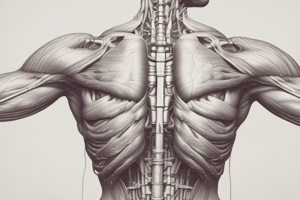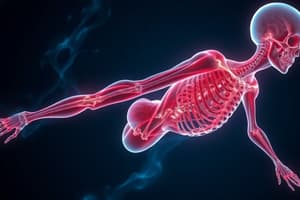Podcast
Questions and Answers
What does the term 'hyperplasia' refer to in the context of muscle physiology?
What does the term 'hyperplasia' refer to in the context of muscle physiology?
- The increase in muscle fiber size
- The decrease in muscle fiber number
- The splitting of muscle fibers to create additional fibers (correct)
- The fusion of muscle fibers
What is 'net protein balance' (NPB) primarily used to determine?
What is 'net protein balance' (NPB) primarily used to determine?
- Whether you build or lose muscle (correct)
- The rate of cardiovascular fitness
- The amount of cardiovascular training required
- The total caloric intake of an individual
Which factor increases muscle protein breakdown as indicated in the content?
Which factor increases muscle protein breakdown as indicated in the content?
- Aging or calorie restriction (correct)
- Strength training
- Increased leucine levels
- Elevated net protein balance
What does positive protein balance indicate?
What does positive protein balance indicate?
What is the interference effect in concurrent training?
What is the interference effect in concurrent training?
What is the primary function of the epimysium in skeletal muscle?
What is the primary function of the epimysium in skeletal muscle?
Which type of muscle fiber is characterized by slow contraction velocity and high oxidative enzyme density?
Which type of muscle fiber is characterized by slow contraction velocity and high oxidative enzyme density?
How do Type IIx fibers differ from Type I fibers?
How do Type IIx fibers differ from Type I fibers?
What is a motor unit composed of?
What is a motor unit composed of?
Which type of muscle fiber has the highest glycogen stores?
Which type of muscle fiber has the highest glycogen stores?
What defines the Size Principle in muscle recruitment?
What defines the Size Principle in muscle recruitment?
Which property of Type I fibers contributes to their resistance to fatigue?
Which property of Type I fibers contributes to their resistance to fatigue?
Which statement accurately describes the difference in force production between fiber types?
Which statement accurately describes the difference in force production between fiber types?
Flashcards
Epimysium
Epimysium
Dense fibrous connective tissue surrounding the entire muscle belly.
Perimysium
Perimysium
Dense fibrous connective tissue that surrounds a fascicle (bundle of muscle fibers).
Endomysium
Endomysium
The innermost connective tissue layer that surrounds individual muscle fibers within a fascicle.
Sarcomere
Sarcomere
Signup and view all the flashcards
Motor Unit
Motor Unit
Signup and view all the flashcards
Type I Muscle Fiber
Type I Muscle Fiber
Signup and view all the flashcards
Type IIa Muscle Fiber
Type IIa Muscle Fiber
Signup and view all the flashcards
Type IIx Muscle Fiber
Type IIx Muscle Fiber
Signup and view all the flashcards
Action Potential: All or None
Action Potential: All or None
Signup and view all the flashcards
Axon Hillock
Axon Hillock
Signup and view all the flashcards
Hyperplasia in Muscle Growth
Hyperplasia in Muscle Growth
Signup and view all the flashcards
Net Protein Balance (NPB)
Net Protein Balance (NPB)
Signup and view all the flashcards
Interference Effect in Training
Interference Effect in Training
Signup and view all the flashcards
Study Notes
Skeletal Muscle Structure and Characteristics
- Skeletal muscle is excitable, meaning motor neurons use action potentials to stimulate contraction.
- It is contractile, meaning it shortens in response to changes in membrane potential.
- Extensible, capable of stretching beyond resting length.
- Elastic, returning to its original length after being stretched.
- Functions include movement production, posture maintenance, joint stabilization, and heat generation.
Muscle Tissue Components
- Epimysium: dense irregular connective tissue surrounding the entire muscle.
- Perimysium: dense irregular connective tissue surrounding fascicles (bundles of muscle fibers).
- Fascicle: bundle of muscle fibers.
- Endomysium: innermost connective tissue layer surrounding individual muscle fibers (cells).
- Myofibril: a group of sarcomeres arranged in a chain.
- Sarcomere: the smallest contractile unit of muscle.
- Z-discs to Z-discs mark the boundary of adjacent sarcomeres.
- Actin (thin) and myosin (thick) myofilaments are proteins interacting within sarcomeres.
- Tropomyosin and troponin regulate actin-myosin binding.
- A band: dark band with overlapping actin and myosin.
- I band: light band with only actin.
- H zone: central region of A band with only myosin.
- M line: center of the H zone.
Motor Units and Fiber Types
- Motor unit: a motor neuron and the muscle fibers it innervates; smallest functional unit.
- Components are motor neuron and muscle fibers.
- Type I (Slow Oxidative): suited for long-distance activities, high mitochondria density, low force production, resistant to fatigue.
- Type IIa (Fast Oxidative Glycolytic): suited for middle-distance activities or activities requiring bursts of energy, moderate mitochondrial density, moderate force production.
- Type IIx (Fast Glycolytic): suited for high-intensity, short-duration activities, low mitochondria density, high force production, fatigable quickly.
Muscle Fiber Properties
- Fiber diameter, hypertrophic potential, mitochondrial density, and capillary density vary among fiber types.
- Type I fibers have a low ratio of fibers to motor neurons, indicating fine motor control.
- Type II fibers have a high ratio of fibers to motor neurons, indicating gross motor control.
Excitation-Contraction Coupling
- Neuromuscular junction: where the nervous system connects with muscles, at the motor end plate.
- Motor end plate is rich in acetylcholine receptors and the junction receives acetylcholine.
- Resting membrane potential (RMP) is -90mV for muscle cells.
- An action potential causes calcium release, which leads to cross-bridge cycling.
- The sarcoplasmic reticulum stores calcium, important for triggering muscle contraction.
Types of Contractions
- Isometric contractions: muscle length does not change.
- Isotonic contractions: muscle length changes.
- Concentric contractions: muscle shortens.
- Eccentric contractions: muscle lengthens.
Studying That Suits You
Use AI to generate personalized quizzes and flashcards to suit your learning preferences.
Related Documents
Description
This quiz explores the structure and properties of skeletal muscle, including its excitability, contractility, extensibility, and elasticity. You'll also learn about the various components of muscle tissue such as epimysium, perimysium, fascicles, myofibrils, and sarcomeres. Test your understanding of how these elements contribute to muscle function.




